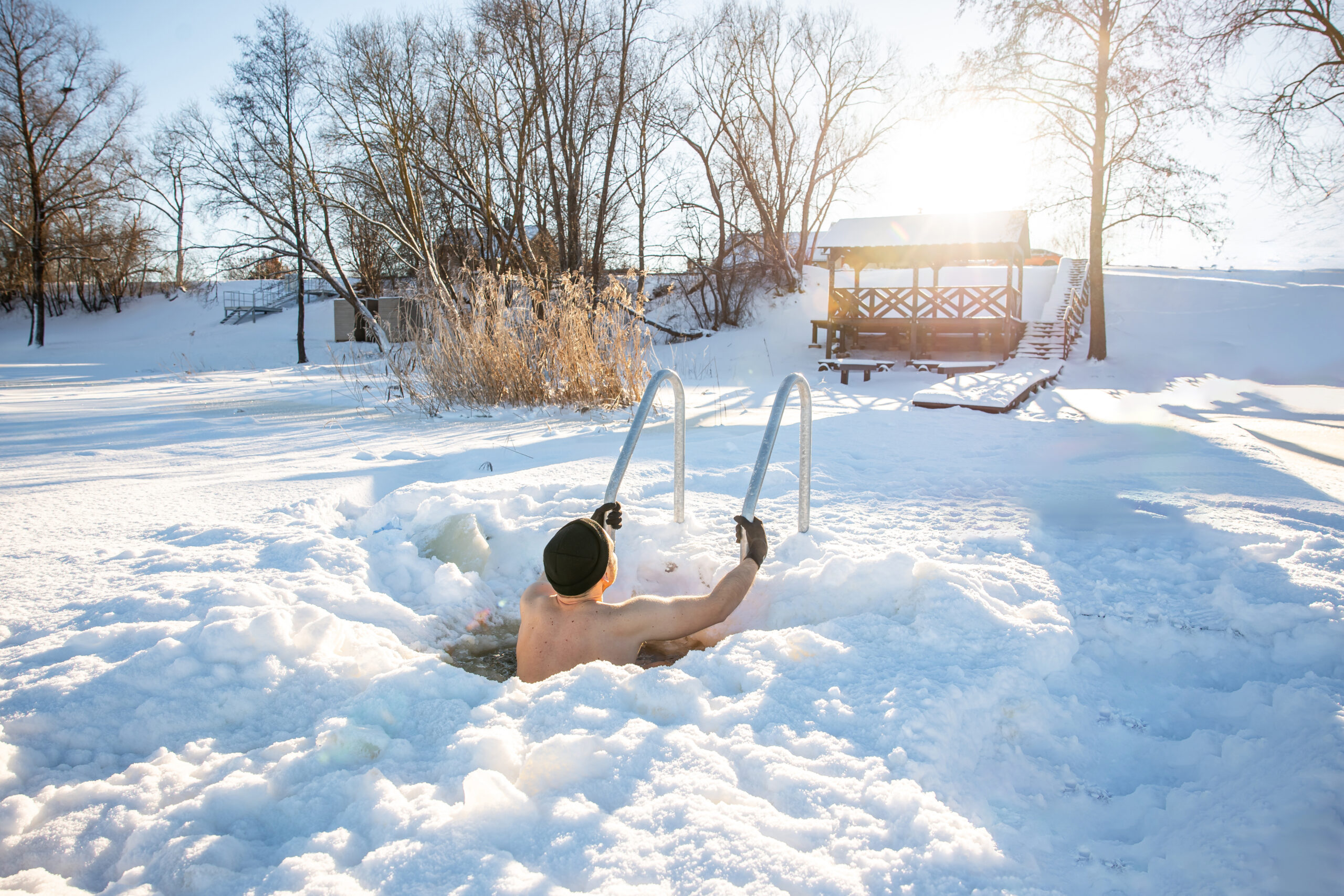Exposed & Uncomfortable: Changing your environment on purpose
Written by Kamren Kubesh
Take a moment to step outside the comforts of tech, as I share with you an experience that some of us in Minnesota engage in during the winter.
Walking out onto cold, barren ice, equipped with a parka and a long 82-inch pole fitted with a 42-inch jagged blade. You effortlessly cut through the ice, sliding the sheets below the transparent surface you stand on. Slowly entering the water one rung at a time. Alarms begin to sound that you are in serious danger, a sense of wonder as the fresh water evaporates while being exposed to the cold air. Water circulates around your body, and you begin to breathe uncontrollably, each sensitive point on your body sounds a new alarm. Finally landing on the soft sand, bobbing slowly around as the air fills your lungs changing your buoyancy.

You begin to slow your breath until you become calm, the water settles, and you are at peace for a moment. Then your body sends a reminder with subtle trembles, signaling that this might not be a peaceful place. Slowly zoning back into a focused state, staring across the ice listening to the sounds around you. Waves of shock and peace wash over you. You complete your time in the water, quickly ascending out of the water, you dry off to remove the water as it wicks away warmth from your body. You put your parka back on as a bundle of relief sets in, your mind forgets the small nagging things from before, your mind begins to focus with the dopamine kick, and you feel energized to do anything the day is about to throw at you.
This was an intentional cold water immersion experience. It is certainly not for everyone, but most people can do this with practice and safety measures. The real question is why? Why on earth would a person voluntarily do this to themselves? The various components of our body including our minds are like muscles. When they become stagnant, they are not able to react to unexpected conditions with grace, panic may set in and we react, even if that means gasping in cold water from shock.
Today, we like to live in comfort. Our houses and vehicles have temperature controls that are consistently set to the same degrees year-round. There are many benefits to this as consistency, it allows you to focus on minute details rather than spending energy trying to get back to a comfortable state. However, over time something unexpected or small might occur throwing you into a bit of a spin. Breaking this cycle of little change and introducing uncomfortable conditions in a controlled setting can help us with being able to adapt to a new scenario. Adapting to the changing environment we live in allows us to adjust quickly and bring new ideas to the table based on previous knowledge and experiences.
What does this have to do with Solution Design Group or consulting? Well, being a consultant means actively practicing being in new environments and solving new problems. Starting a new job anywhere can be uncomfortable. You must do your best to follow the new systems, business language, and goals you are working towards. Consulting can feel like starting a new job regularly; for some, this might seem a bit overwhelming. You are dropped into an unknown place. Each scenario is unique and how you react can really determine the results of the project at hand. It takes some practice and a bit of getting out of your head to see the horizon that you’re all working towards.
As I come to appreciate being uncomfortable, I have started to see the similarities of cold exposure and its relationship to consulting. I have broken this up into five parts that expand on the connections between the two.
- Committing to Showing Up
- Establishing Support Structures
- Embracing the Journey
- Embodying Humility and Openness
- Acknowledging Progress
Committing to Showing Up: In both scenarios, half the battle is won by simply showing up and being fully present. Just as one equips themselves with the necessary knowledge, tools, and gear for cold exposure, a consultant must arrive prepared to contribute effectively. Consulting requires you to be thoughtful of the impacts of your work on the team, business, and their goals.
Establishing Support Structures: Similar to identifying safety measures before venturing into the cold, consultants must establish support structures within their projects. Building a robust network ensures smooth navigation through potential challenges and fosters a collaborative environment. Connection to others who are knowledgeable and can serve as advocates are important to making you an effective team member.
Embracing the Journey: It’s crucial to slow down and appreciate the journey in both spaces. The cold allows you to be more thoughtful of your environment and those who are with you out in the water. Taking the time to acknowledge the dynamic work environment and product as it helps nurture a deeper understanding and build richer experiences for your team and their customers.
Embodying Humility and Openness: Knowing one’s limits and being open about them is vital. Whether it’s recognizing the chilling depths of unfamiliar territories or acknowledging gaps in knowledge, humility lays the foundation for growth and collaboration. Brings awareness to the strong skill set and areas where you could see some growth.
Acknowledging Progress: Reflecting on personal growth and celebrating collective achievements is paramount. Just as one identifies milestones during cold exposure, consultants should recognize their journey’s progress and the growth of their team members.
As we reflect on the connections between cold exposure and consulting, let us remember that discomfort is not merely a hurdle to overcome but a catalyst for growth. Just as our bodies adapt to the shock of cold-water immersion, our professional skill sets can thrive when exposed to discomfort and uncertainty. Much like muscles that strengthen through regular exercise and stretching, our abilities to innovate, collaborate, and adapt are honed through experiences that push us outside of our comfort zones.
By embracing discomfort and recognizing its role in shaping our growth, we cultivate resilience, adaptability, and innovation in both our personal and professional lives. Let us approach each challenge with the same determination and openness that we bring to intentional discomfort, knowing that every moment of discomfort is an opportunity for learning and development. As we continue our journeys, may we not shy away from being uncomfortable, but rather, embrace it as a necessary step towards growth and potential.
